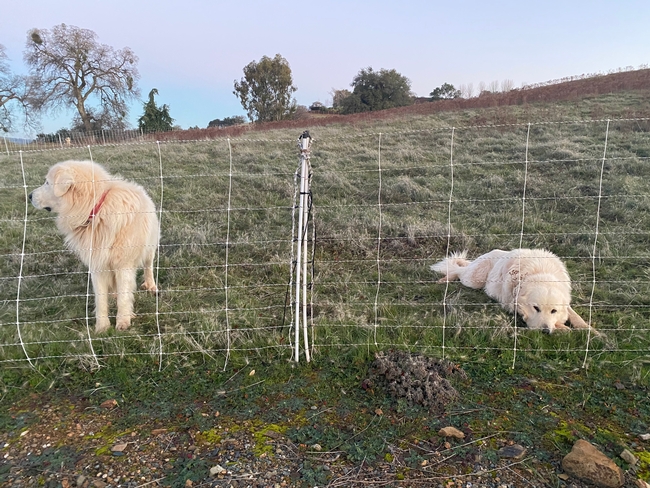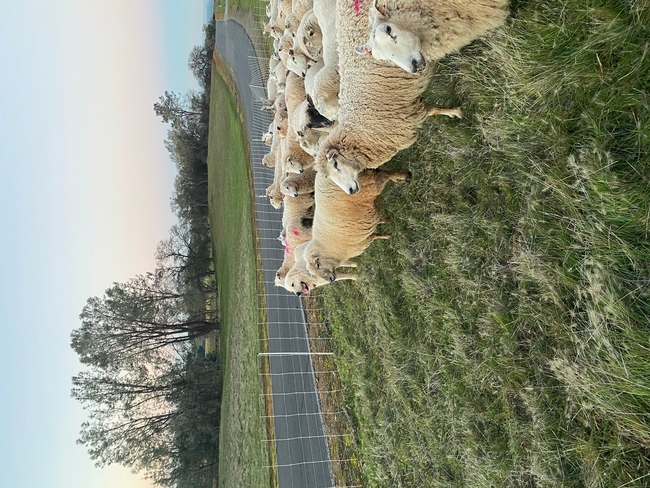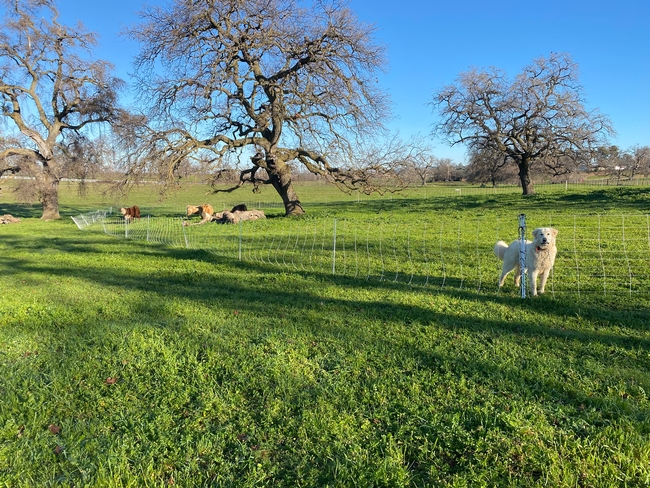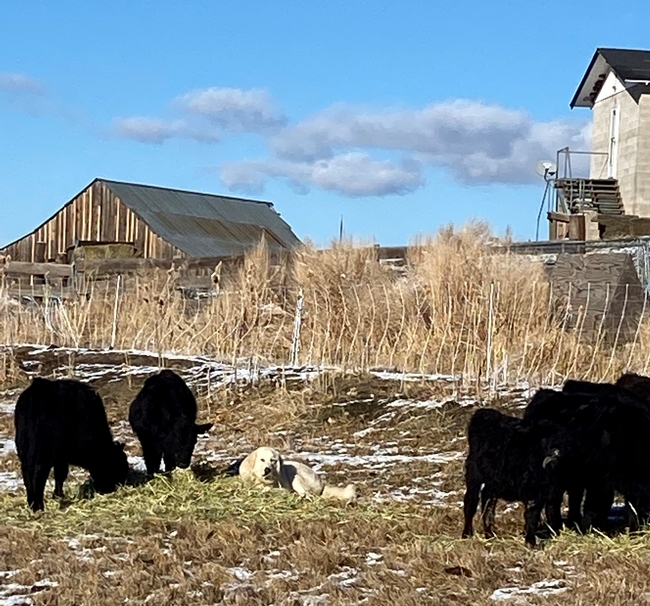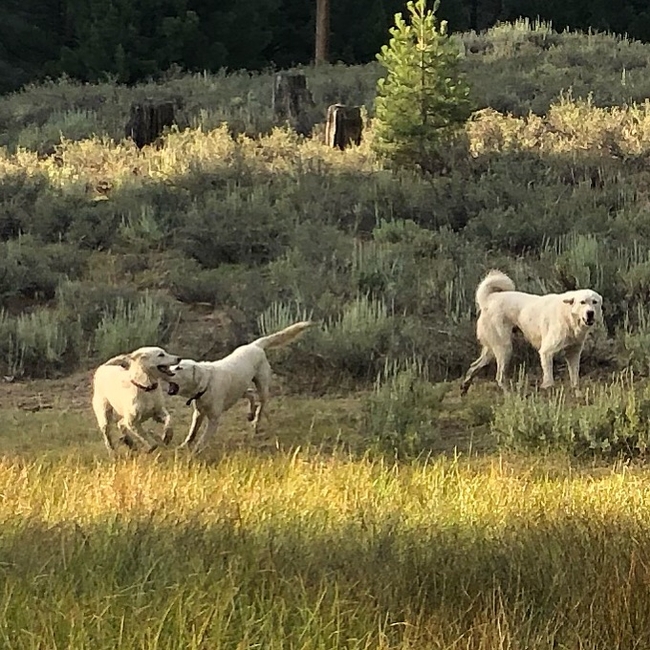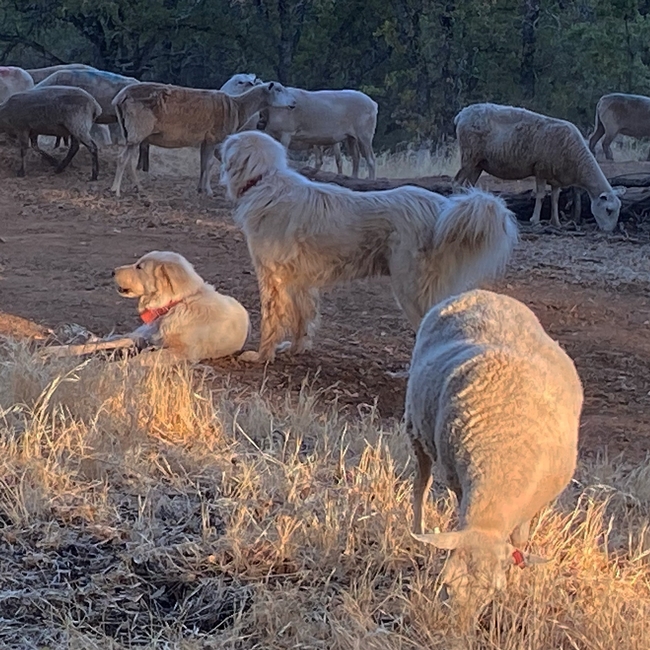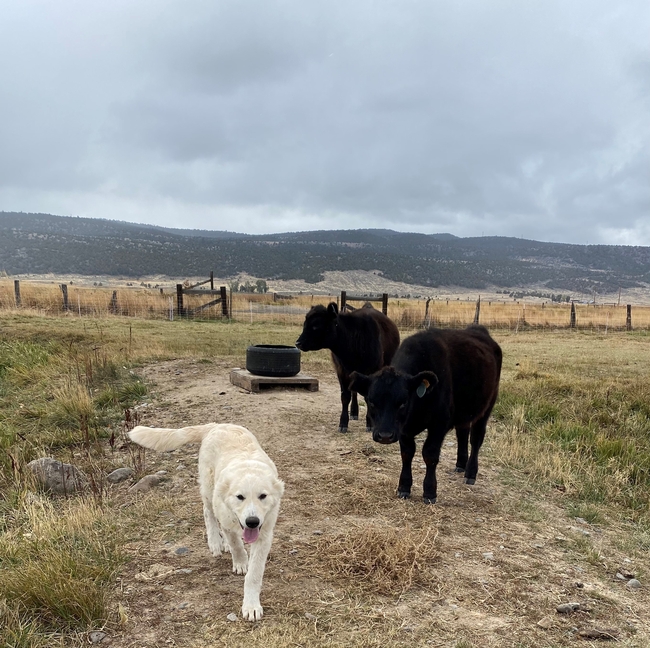- Author: Dan Macon
Predator Protection in Rangeland Livestock Operations
One of the first projects I worked on when I started this job was a publication called Livestock Protection Tools for California Ranchers. Working with a number of other advisors and extension specialists, we took a detailed look at the variety of “tools” that ranchers could use to protect their livestock from predators – everything from livestock guardian dogs to electric fencing, and every predator from neighbor dogs to gray wolves. But as I've studied livestock-predator conflict more thoroughly, and as I've thought about how I protect my own sheep from predators, I've come to think that maybe “tool” is the wrong word. Protecting livestock from predators on rangeland takes a systems approach – one that reflects the overlapping ecology of grazing livestock and rangeland predators. A system that reflects an understanding of human, livestock, and predator behavior – and how these behaviors interact.
I'll use our sheep operation to illustrate what I'm trying to say here. We graze just shy of 100 wool-breed ewes on annual rangeland, irrigated pasture, and irrigated crop land, all within 7 miles of Auburn. The predators we've observed in our environment include mountain lions, black bears, coyotes, foxes, bobcats, domestic dogs, and golden and bald eagles. We also have birds that other producers might include on this list – crows and magpies. We lamb from late February through the end of March (when the grass on our annual rangelands is starting to grow rapidly). We move to irrigated pasture in April. In late June, we wean the lambs and sell most of them; the lambs we keep stay on irrigated pasture, while the ewes move back to annual rangeland. In late August, the ewes come back to irrigated pasture and/or cropland, where they stay through flushing and breeding. In early December, the entire flock moves back to annual rangeland.
Predator pressure varies by location and time of year. We tend to see more wild predators on annual rangeland, although we have seen coyotes in our irrigated pastures. We see more domestic dogs closer to town. We see eagles rarely, but we do see them. We have trail camera photos of a mountain lion within 30 yards of the paddock where we were lambing several years ago. We have too many photos of coyotes to count.
Mostly, we rely on our livestock guardian dogs and our electro-net fencing to keep predators away from our sheep. We know they work – because we've lost sheep where we didn't have both tools (in hard-wire fences without a dog), but I couldn't tell you which “tool” was more important. We've also used FoxLights™ - a randomly flashing light that supposedly deters coyotes and foxes. When we have sheep at home, we'll put them in a secure pen at night (e.g., night-penning) if we need to.
But our system encompasses more than dogs and fencing. We move the sheep every 3-7 days for most of the year. Mostly these are moves to an adjacent pasture, but I suspect the fact that the sheep are never in the exact same spot for very long helps confound the predators to some degree. We add dogs – and more human presence – during lambing, when we're especially vulnerable. We have focused on ewe genetics on maternal qualities – which for us includes vigorous lambs and protective ewes who can keep track of their young.
All of this might seem to be a matter of perspective – or vocabulary! One rancher's “toolbox” might be another rancher's “system.” But as we start talking about impacts from predators, and the costs associated with these impacts, I've come to think we need to take a broader view.
The California Department of Fish and Wildlife received funding in last year's budget to help offset the cost of nonlethal predator deterrents for ranchers. By taking a systems perspective on this question, I think we can help the agency understand that most producers are already doing things to mitigate predator problems. Rather than asking, “what tools are you using?” we should be asking, “How have you changed your management to avoid conflict with predators?” Are there parts of your range you don't use during certain times of year? Are you riding through the heifer field more often? Are you adding extra livestock guardian dogs to your operation so you have enough dog power during lambing or kidding? Are you giving up leases because the predator pressure is just too intense? Some of these are “tools,” obviously, but some are systematic changes to our operations. Regardless, they all have costs. And in my mind, they should all be considered when it comes to any kind of predator deterrent cost-sharing program.
Finally, all of these systematic considerations regarding predators have to fit within the larger context of our ranching systems. Not only do we need to think about avoiding or resolving conflicts with predators, we have to think about our marketing windows. We have to fit our genetics both to our environment and to the marketplace. We need to consider the cost of – and return to – labor (our own labor as well as that of our employees, if we have any). We need to think about short term cash flow and long term investment. We often need to satisfy the needs of our landlords, our families, our bankers, and others connected to our businesses. We have to be good neighbors. This larger context influences the choices we have available to us when it comes to predator protection. For me, the idea of a system (as opposed to a tool box) better reflects the complexity of coexisting with wildlife.
- Author: Dan Macon
If you've been following our effort to demonstrate techniques for bonding livestock guardian dogs (LGDs) with cattle (either on this blog or through my @flyingmulefarm Twitter or Facebook accounts), you'll know that Sam the LGD pup got off to a great start on large cattle operation in Modoc County in 2021. But after their first significant snowfall of the year, and the realization that their heifers would begin calving shortly after the Holidays, the ranch decided that they simply didn't have the bandwidth to continue with the project. In the week before Christmas, I brought Sam back to Placer County – he spent the Holidays with my sheep and one of my mature LGDs, Bodie.
During Sam's “vacation,” I happened to visit with JC Baser, a local cattle producer who has experienced increasing problems with coyotes during his last several calving seasons. JC is on the board of our local Tahoe Cattlemen's Association, and his whole family is involved in their operation. He'd heard me talk about the project at board meetings, and called me one morning to talk in more detail.
The Baser's ranch is typical of many foothill cattle operations. They graze on leased rangeland in the winter time, and leased and owned irrigated pasture in the summer time. Perhaps atypically, however, they've created a great market for show cattle – fair steers and fancy heifers. They're also innovators when it comes to reproductive technology – utilizing artificial insemination and other techniques to continuously improve their genetics. And from the perspective of this project, they're willing to try new things!
After the first of the year, I toured the Baser's winter ranch, where they're currently calving. The following week, I worked with Garrett and Levi (JC and Michelle's sons) to set up an electro-net paddock near their barn. They put four heifers in the paddock; I added Sam. And the demonstration project was off and running in a new location!
Sam is now nearly 8 months old – in the midst of his “terrible teens” (the time period with most young LGDs seem to be puppy enough to want to play but big enough to play too roughly with livestock). As we introduced him to his new environment, he took special interest in JC and Michelle's youngest daughter (who's 5 years old). They've since reported that he continues to be fixated on her when she's nearby – and so they've limited her contact with Sam (since we want Sam to bond with cattle rather than people).
When we introduced Sam to the heifers, he barked a bit and tried to keep them away from us. I walked through the heifers and growled at Sam if he looked like he wanted to chase. Within about 10 minutes, he'd settled in. The heifers also seemed to settle – they were curious about their new fuzzy white pasture mate, but they quickly went back to grazing.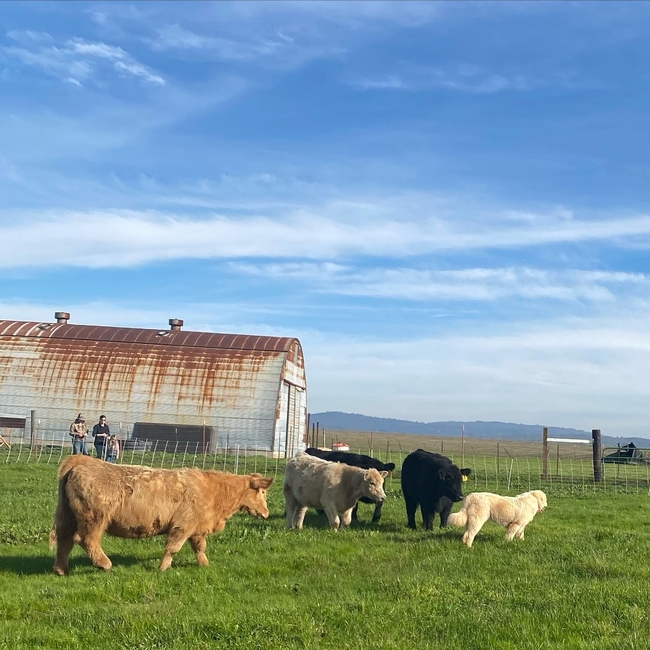
That was all 13 days ago. Yesterday, I visited the Basers and got an update on Sam's progress. They reported that for the first several days, when they arrived (and Sam knew they were there), he would herd the heifers around the paddock, nipping at their heels. On the occasions where they could observe Sam without his knowledge, however, he was content to be with his cattle. Late last week, they added an older dry cow to the mix. Sam tried to keep her separated from the heifers for about 10 minutes, but then settled back down. Today, he was excited to see me – and followed me through the paddock as I went to see the cattle. Once I was back outside the fence, however, he decided he'd rather be with the cattle than watch us – all positive signs.
The Basers also reported that Sam definitely barks at external stimuli – whether it's the rancher next door checking his cattle, or the sound of a coyote. This responsiveness is perhaps the most important tool in and LGDs tool box – in some cases, announcing their presence (through barking and scent marking) appears to deter predators.
Our next steps with Sam will be to introduce several cows with older calves at their sides. I suspect this introduction will be a two-way process – mother cows can be protective of their calves, so they may be more suspicious of the dog in their pasture. Conversely, Sam needs to get comfortable with the entire herd – and with the changes that occur (calving, weaning, etc.) in any commercial livestock setting. I'm hopeful he'll handle this new transition well, but we'll be watching closely.
For now, Sam remains inside an electro-net paddock, which keeps him with “his” cattle. Eventually, we hope that he'll be well-enough bonded with the ranch livestock that we won't need the eletro-net. We'll also work to get him trained to eat from an automatic feeder in a creep-feeding set-up – the labor of daily feeding is one of the drawbacks that many ranchers cite about using LGDs. And, like the final exam we subject our sheep-guarding dogs to, Sam will need to prove trustworthy during the calving process. These are all developments that will hopefully be natural as Sam matures. For now, however, he continues to make the progress I'd expect from an 8-month-old dog.
- Author: Dan Macon
On to the Next Phase
We've reached a new phase in our effort to learn how to bond a livestock guardian dog with cattle. As we described in previous blog posts, we are learning that we need to bond Sam, our 7-month old LGD puppy, with cattle – and vice versa. The cattle need to be as comfortable with Sam as he is with them – and so we'll be trying Sam in a new setting, with new cattle, after the first of the year.
The ranch we'd been collaborating with was planning to try Sam with a group of bred heifers they're keeping in close to their headquarters (they're due to start calving next month). The heifers, we were thinking, were more curious than older cows, which would hopefully help them accept Sam more readily. For the initial part of this new phase, we planned keep Sam fenced in an electronet paddock in the midst of the heifer field – the heifers would be fed and access water in close proximity, but the electric fence would prevent direct contact initially.
But then the ranch received about 10 inches of snow….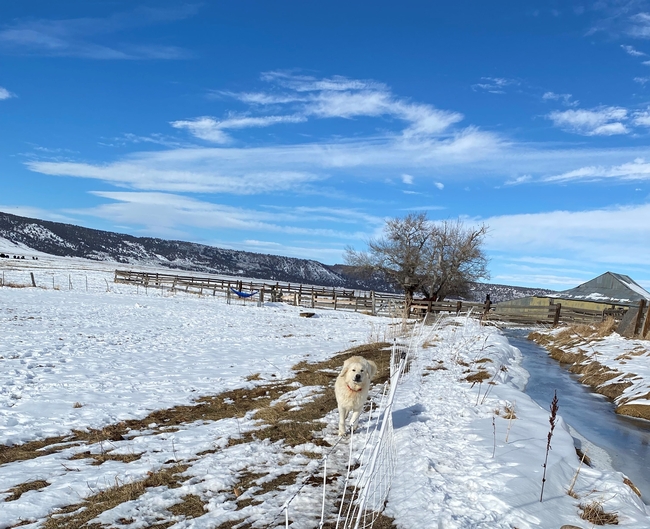
Snow is hard on electronet fencing – the weight knocked down sections of the fence, allowing the calves and Sam to get out into the larger pasture. On the plus side, Sam clearly demonstrated that he preferred being with the calves. While he'd come up to the ranch buildings when there was activity, he always returned to his calves. On the negative side, however, the ranch felt that our plan to keep Sam in electronet fencing in the heifer pasture was not workable with more snow in the forecast. On December 20, I traveled to Likely one last time and retrieved Sam. We'll move on to a new phase of the project!
I should note that Sam traveled well – the ranch trained him to walk on a lead and to be tied out, and he made the 4-hour trip in a dog crate without soiling the crate, crying, or barking.
For the short term, this new phase involves putting Sam with a handful of rams at our home place. He's also with our oldest and best dog, Bodie. We don't typically put a small pup with an older dog (as we want the pup to bond with livestock first). As a pup matures, however, an older dog can help reinforce the importance of respect for the livestock - Bodie has already corrected Sam several times.
While Sam continues to mature physically, he also continues to behave like a puppy on occasion – a puppy who weighs 80 pounds or more! In Likely, Sam demonstrated that he still liked to play with the orphan calves he was pastured with. This behavior included licking and sometimes gently biting their ears and faces, and bounding up to the calves if they were grazing at a distance. While the ranch corrected this behavior when observed, Sam couldn't be observed around the clock. Similarly, he was initially overly enthusiastic about the rams he's with now - so we're trying a tool that I've used on other young dogs that were exuberantly playful.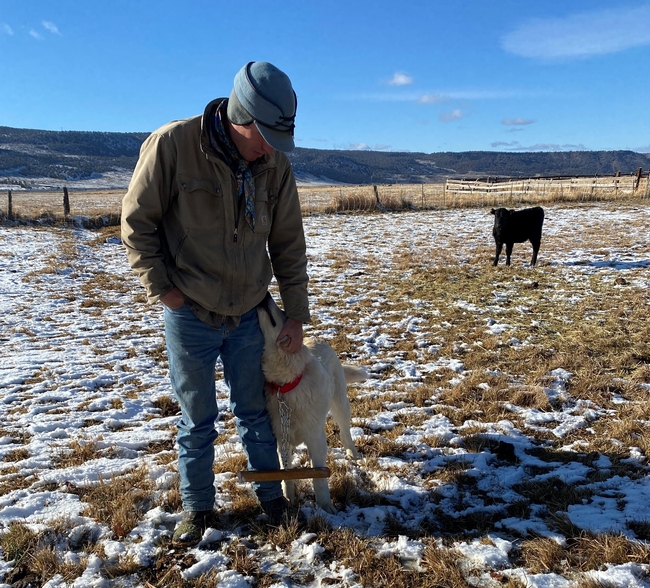
A dangle stick is a device that hangs from a dog's collar and makes running and jumping uncomfortable. Comprised of a piece of wood, short pipe, or weighted piece of PVC attached to a chain, the dangle stick hits a dog in the mid-leg area, making this activity uncomfortable. This discomfort, which is alleviated when the dog is walking calmly, corrects the unwanted behaviors – in other words, it makes the right behavior easy and the wrong behavior difficult. The dog can correct himself!
When we first attached the dangle stick to Sam's collar, he was annoyed by it – he chewed on the chain. Within several minutes, however, he accepted it and learned how to navigate the pasture with it. Over the last several days, I've watched Sam bound after the rams, only to have the stick knock against his legs. He stopped running and walked up to them calmly – just the effect we were looking for. Sam will wear the dangle stick for several weeks – and then we'll assess his behavior without it. If he reverts to his old puppy habit of running up to the livestock, we'll put it back on.
After the holidays, we'll place Sam on another cattle ranch here in the Sierra Foothills. This new ranch is a bit smaller (both in terms of acreage and livestock), but is having significant coyote issues during calving. We'll work with this new outfit to introduce Sam to the cattle and vice versa – with the hope that Sam and the cattle will eventually accept one another. While Sam still needs to prove himself, we hope that controlling his interaction with the cattle in a new operation will help further his training. I've observed similar challenges in bonding naïve sheep with LGDs – sheep that have been raised to be afraid of dogs don't immediately trust these big white dogs. In my experience, this is where the dog's submissive behaviors are so critical. While play behavior can be excused, aggressive or dominant behavior can't be. We'll be watching Sam for continued submissiveness as he moves into this new environment. We'll also be watching the cattle to see if they begin to accept this big white dog in their pasture. And as always, we'll be monitoring Sam's desire to stay with livestock. Stay tuned!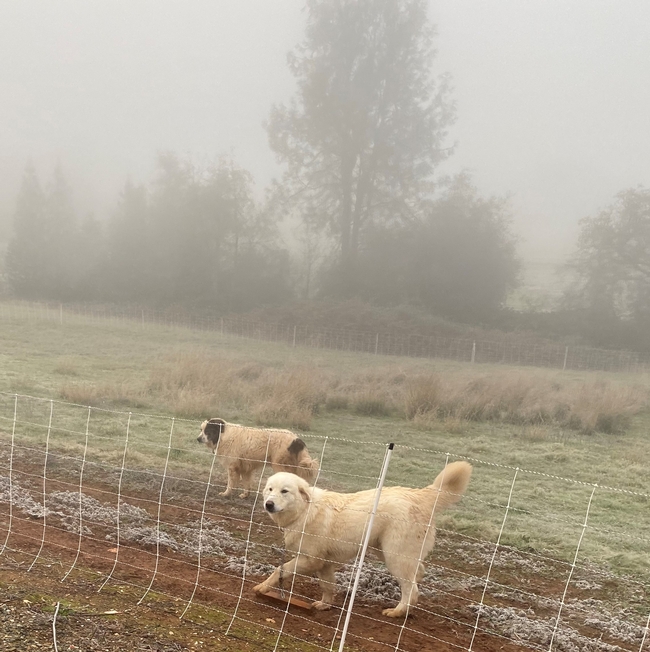
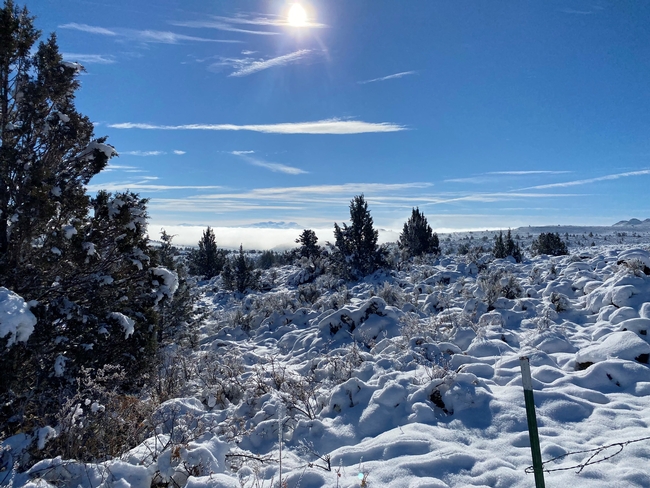
- Author: Dan Macon
One of the hazards of referring to livestock guardian dogs (LGDs) as predator protection “tools” is that we seem to think of them like other tools. While one claw hammer might be reasonably interchangeable with any other claw hammer, I've found that every LGD I've worked with is an individual with his/her own personality, strengths, and weaknesses. Just as I wouldn't use a claw hammer to install a wood screw, I wouldn't use each of my dogs identically. That said, I certainly didn't realize this nuance when I started using LGDs!
Researchers (and I include myself in this) have a tendency to want neat models against which to test our hypotheses. This approach can lead to “hard-and-fast” rules that might work for experiments but that have little basis in real-world management. For example, there are several scientific papers that suggest that the proper ratio of LGDs to livestock is 1 to 100 – that is, for every 100 sheep in a flock (or cows in a herd), a rancher needs one dog to optimize predator protection. In reality, the ratio of dogs to livestock is much more fluid; it depends on the individual dog, the predator pressure and environment, the stage of production for the operation, and a host of other factors. The researcher part of me wants this definitive ratio; the rancher and extensionist in me knows the answer to question, "how many dogs," is always, “It depends.”
We currently havethreeLGDs in our small sheep operation, which is at least one too many for part of the year. During our 6-week breeding season, we have three groups of sheep (two breeding groups and our replacement ewe lambs, which are not big enough to breed). Typically, we keep one dog with each group. Following breeding, however, we combine all three groups into one larger mob and separate the rams. In our environment (and since we also use electric fence), one dog can usually protect the big mob until we start lambing in late February. Depending on where we put the rams post-breeding, we can sometimes get by without putting a dog with them. Once we start lambing, though, the dogs' work becomes more challenging. We lamb during a time of year when there is not much “natural” prey for the coyotes and mountain lions here in the foothills. We lamb on pasture, typically in paddocks that are 8-10 acres in size, with rolling terrain and substantial brush and/or tree cover. Consequently, we find that we're more comfortable with two dogs during lambing (as are the sheep). Once we wean the lambs in late June, we run the replacement ewe lambs and feeders separate from the main flock again – and keep a dog with each bunch.
Over the last four summers, I've been working with a large-scale sheep operation that grazes on the Tahoe National Forest north of Truckee. They typically turn out 3,000-plus ewes and rams in three bands of roughly 1,000 ewes each. These are dry ewes; that is, they don't have lambs at their sides. While there are many predators present on the landscape (our trail cameras have picked up coyotes and black bears, and gray wolves have occasionally traversed the region), there is also a plentiful supply of natural prey – fawns, in particular, but other smaller mammals, as well. As a result, the sheep operation has been able to get by with just 1 to 4 dogs per band – and has experienced fewer than 5 ewes lost to predators in the four years I've been researching their use of dogs.
Most cattle producers in California have little experience in working with LGDs, and their natural assumption is that the dogs need to protect all of the cattle, all of the time. In talking with ranchers in the Northern Rockies who are using LGDs to protect cattle, I suspect the reality of using dogs with cattle is based on the situation – just as it is with sheep. Dogs are placed with groups of cattle that are particularly vulnerable to predators – first calf heifers during calving season, for example, or stocker cattle that may be grazing in an area with greater predator pressure. Other classes of cattle may not be as susceptible to predators – because of the stage of production or the area in which they're grazing.
This situational approach suggests that some producers have specific times of year when they may not need ANY dogs. Again, unlike that claw hammer, a dog can't simply be put back in the tool box and stored until needed. We “store” our extra dogs with our sheep – at the moment, we have two dogs with one of our breeding groups, even though one would suffice. Other ranchers tell me that they sometimes kennel an extra dog for short periods, or they'll allow a well-bonded dog to decide which particular group of livestock it wants to “protect.”
Understandably, fitting LGDs into a complex cattle operation might be difficult. Consider an operation that manages cattle with multiple irons and/or ownership arrangements, on a combination of owned and leased private land, as well as federal land. Add in stocker cattle (which may be owned or grazed for other producers), heifers that may need a little extra attention at calving, grazing permits that require cattle to be dispersed out of riparian areas, and other considerations – adding dogs quickly becomes extremely complicated. Other predator protection tools might be more viable. And each ranch will likely have some level of predator problems that are within acceptable limits.
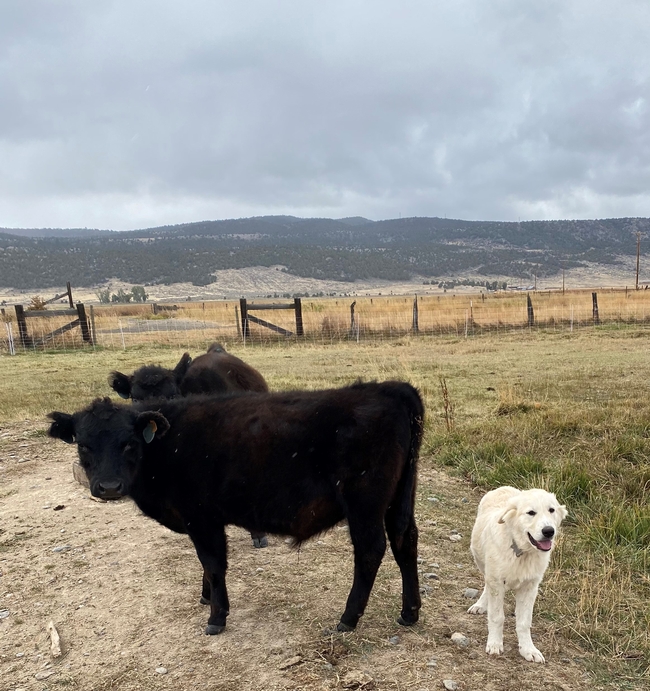
- Author: Dan Macon
- Author: Laura Snell
Bonding works both ways...
Bonding a livestock guardian dog (LGD) to livestock is a critical first step in using dogs to protect livestock from predators. Practically, the bonding process helps ensure that the dog will stay with livestock; economically, successful bonding improves the cost effectiveness of this tool. But as I've learned in bonding my own LGDs with our sheep, the bonding process has to work in both directions. The dog must be bonded to the livestock, obviously; naïve livestock take some time to bond to the dog, as well. We're learning this lesson again as we're bonding Sam the LGD pup with cattle in Likely, CA.
Several weeks ago, our rancher-collaborator, Myles Flournoy, needed to work some calves – and decided to work the seven orphaned calves that had been bonding with Sam. Myles had some smaller orphaned calves that he intended to replace them with; figuring a new set of calves would be helpful in Sam's progress. I would have figured the same thing.
These new calves had been around herding dogs, but never a 50+ pound goofball of a puppy. Sam was excited to meet his new “friends.” The calves, unfortunately didn't share his enthusiasm. Myles reported that Sam clumsily bounded up to the calves – and proceeded to push them through the electric fence, leaving Sam sitting next to the now flattened electro-net! The new calves had not been exposed to electric fence, nor had they been fed grain (as the first calves had been) – these new experiences made the transition even more challenging. Myles sorted off two of the original calves and added them back to the pasture – they were happy to see Sam! Myles reported that it took more than two weeks of uncertainty, but by the time I visited the ranch on October 13, the new calves had settled down, as well. And the bonding process continues.
I've noticed a similar dynamic when I've purchased sheep that have not been with an LGD. The naïve sheep are typically afraid of the dogs – probably because all of their prior interactions with dogs have been with herding dogs or with dogs that are chasing them for sport. I've found if we combine the new sheep with our own ewes (who know and trust our LGDs), they settle down quickly.
Ranchers who use LGDs with cattle report comparable observations. Cat Urbigkit, a Wyoming sheep and cattle rancher who uses LGDs extensively, tells me that she will introduce dogs to uninitiated cattle along with two or three steers or heifers that are well-used to the LGDs. Having cattle that trust the dogs seems to calm the new cattle more quickly. Jill Hackett, who runs a cow-calf and sheep operation in Humboldt County, says it took about 6 months for her cattle to completely bond to the dogs. Anna Harvey, who ranches in Sierra Valley, says it took longer than that initially, but now that there are cows in her herd who are used to the dogs, it only takes two days for the new cattle to become comfortable with the LGDs.
In observing our sheep with our dogs – and in observing Sam with his calves yesterday – this reciprocal bonding becomes evident. Some of our sheep will actively seek the dogs when they bed down. Myles reported that when he returned the two original calves the pasture, they walked over and nuzzled Sam (a phenomenon I observed yesterday, as well). The benefit of this reciprocal bonding has practical implications beyond keeping livestock and dogs together. A research project at the U.S. Sheep Experiment Station in Dubois, ID, found that ewes and lambs grazing in the company of an LGD traveled greater distances: “Our findings support the hypothesis that sheep with LGDs spend less time being vigilant for predators and more time moving,” the researchers reported, adding “As a result of traveling greater distances, ewes may also be exposed to more and varied foraging opportunities. The observed changes in movement behavior may result in more effective use of pasture resources” (Webber, B. et. al 2015 - read the abstract here).
Sam still has a long road ahead of him – he is still a puppy, after all! But I am impressed with the progress he's made – and with the progress the calves are making. And once again, we are incredibly thankful for the work that Myles and the entire Likely Land and Livestock crew are putting into this effort! Stay tuned!


